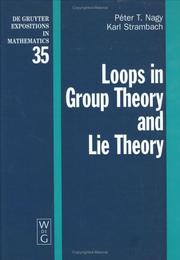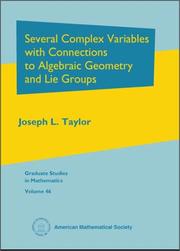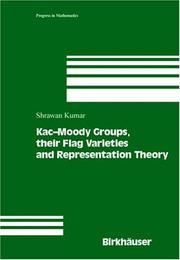| Listing 1 - 10 of 15 | << page >> |
Sort by
|

ISBN: 3110170108 Year: 2002 Publisher: Berlin de Gruyter
Abstract | Keywords | Export | Availability | Bookmark
 Loading...
Loading...Choose an application
- Reference Manager
- EndNote
- RefWorks (Direct export to RefWorks)

ISBN: 0199202516 9780199202515 0198596839 9780198596837 Year: 2002 Volume: 5 Publisher: Oxford: Oxford university press,
Abstract | Keywords | Export | Availability | Bookmark
 Loading...
Loading...Choose an application
- Reference Manager
- EndNote
- RefWorks (Direct export to RefWorks)
This book is an introduction to the theory of Lie groups and their representations at the advanced undergraduate or beginning graduate level. It covers the essentials of the subject starting from basic undergraduate mathematics. The correspondence between linear Lie groups and Lie algebras is developed in its local and global aspects. The classical groups are analyzed in detail, first with elementary matrix methods, then with the help of the structural tools typical of the theory of semisimple groups, such as Cartan subgroups, root, weights and reflections. The fundamental groups of the classical groups are worked out as an application of these methods. Manifolds are introduced when needed, in connection with homogeneous spaces, and the elements of differential and integral calculus on manifolds are presented, with special emphasis on integration on groups and homogeneous spaces. Representation theory starts from first principles, such as Schur's lemma and its consequences, and proceeds from there to the Peter-Weyl theorem, Weyl's character formula, and the Borel-Weil theorem, all in the context of linear groups.
512.81 --- 512.81 Lie groups --- Lie groups --- Groups, Lie --- Lie algebras --- Symmetric spaces --- Topological groups --- Lie groups. --- Groupes de Lie

ISBN: 0821827642 Year: 2002 Publisher: Providence, R.I. American Mathematical Society
Abstract | Keywords | Export | Availability | Bookmark
 Loading...
Loading...Choose an application
- Reference Manager
- EndNote
- RefWorks (Direct export to RefWorks)
Group theory --- Topological groups. Lie groups --- Lie groups. --- Functional analysis. --- Analyse fonctionnelle. --- Lie, Groupes de. --- Functional analysis --- Lie groups --- Groups, Lie --- Lie algebras --- Symmetric spaces --- Topological groups --- Functional calculus --- Calculus of variations --- Functional equations --- Integral equations
Book
ISBN: 1281929506 9786611929503 9812777083 9789812777089 9781281929501 Year: 2002 Publisher: River Edge, N.J. World Scientific
Abstract | Keywords | Export | Availability | Bookmark
 Loading...
Loading...Choose an application
- Reference Manager
- EndNote
- RefWorks (Direct export to RefWorks)
This book constitutes the proceedings of the 2000 Howard conference on "Infinite Dimensional Lie Groups in Geometry and Representation Theory". It presents some important recent developments in this area. It opens with a topological characterization of regular groups, treats among other topics the integrability problem of various infinite dimensional Lie algebras, presents substantial contributions to important subjects in modern geometry, and concludes with interesting applications to representation theory. The book should be a new source of inspiration for advanced graduate students and esta
Infinite dimensional Lie algebras --- Infinite groups --- Infinite-dimensional manifolds --- Lie groups

ISSN: 00659266 ISBN: 0821828118 Year: 2002 Publisher: Providence, R.I. American Mathematical Society
Abstract | Keywords | Export | Availability | Bookmark
 Loading...
Loading...Choose an application
- Reference Manager
- EndNote
- RefWorks (Direct export to RefWorks)
Ordered algebraic structures --- Lie algebras. --- Lie, Algèbres de. --- Lie algebras --- Algebras, Lie --- Algebra, Abstract --- Algebras, Linear --- Lie groups
Book
ISBN: 0821827928 Year: 2002 Publisher: Providence, R.I. American Mathematical Society
Abstract | Keywords | Export | Availability | Bookmark
 Loading...
Loading...Choose an application
- Reference Manager
- EndNote
- RefWorks (Direct export to RefWorks)
Topological groups. Lie groups --- Ordered algebraic structures --- Lie groups. --- Compact groups. --- Root systems (Algebra) --- Lie, Groupes de --- Groupes compacts --- Systèmes de racines (algèbre) --- Compact groups --- Lie groups --- Systems of roots (Algebra) --- Lie algebras --- Groups, Lie --- Symmetric spaces --- Topological groups --- Groups, Compact --- Locally compact groups --- Lie, Groupes de. --- Groupes compacts.

ISSN: 16152085 ISBN: 1852334703 9781852334703 1447101839 Year: 2002 Publisher: London: Springer,
Abstract | Keywords | Export | Availability | Bookmark
 Loading...
Loading...Choose an application
- Reference Manager
- EndNote
- RefWorks (Direct export to RefWorks)
"Aimed at advanced undergraduate and beginning graduate students, this book provides a first taste of the theory of Lie groups as an appetiser for a more substantial further course. Lie theoretic ideas lie at the heart of much of standard undergraduate linear algebra and exposure to them can inform or motivate the study of the latter. The main focus is on matrix groups, i.e., closed subgroups of real and complex general linear groups. The first part studies examples and describes the classical families of simply connected compact groups. The second part introduces the idea of a lie group and studies the associated notion of a homogeneous space using orbits of smooth actions. Throughout, the emphasis is on providing an approach that is accessible to readers equipped with a standard undergraduate toolkit of algebra and analysis. Although the formal prerequisites are kept as low level as possible, the subject matter is sophisticated and contains many of the key themes of the fully developed theory, preparing students for a more standard and abstract course in Lie theory and differential geometry." [Publisher]
Matrix groups --- 512.81 --- 512.54 --- 512.64 --- 512.64 Linear and multilinear algebra. Matrix theory --- Linear and multilinear algebra. Matrix theory --- 512.54 Groups. Group theory --- Groups. Group theory --- 512.81 Lie groups --- Lie groups --- Group theory --- Matrices --- Matrix groups. --- Topological groups. --- Lie groups. --- Matrix theory. --- Algebra. --- Differential geometry. --- Mathematical physics. --- Group theory. --- Topological Groups, Lie Groups. --- Linear and Multilinear Algebras, Matrix Theory. --- Differential Geometry. --- Theoretical, Mathematical and Computational Physics. --- Group Theory and Generalizations. --- Groups, Theory of --- Substitutions (Mathematics) --- Algebra --- Physical mathematics --- Physics --- Differential geometry --- Mathematics --- Mathematical analysis --- Groups, Lie --- Lie algebras --- Symmetric spaces --- Topological groups --- Groups, Topological --- Continuous groups --- Matrices, Groupes de --- Lie, Groupes de

ISBN: 1283329506 9786613329509 1139133977 1139129066 0511579055 0511578318 0511579799 9781139129060 0521771838 9780521771832 0521777402 9780521777407 Year: 2002 Publisher: Cambridge, UK New York Cambridge University Press
Abstract | Keywords | Export | Availability | Bookmark
 Loading...
Loading...Choose an application
- Reference Manager
- EndNote
- RefWorks (Direct export to RefWorks)
Symmetry analysis based on Lie group theory is the most important method for solving nonlinear problems aside from numerical computation. The method can be used to find the symmetries of almost any system of differential equations and the knowledge of these symmetries can be used to reduce the complexity of physical problems governed by the equations. This is a broad, self-contained, introduction to the basics of symmetry analysis for first and second year graduate students in science, engineering and applied mathematics. Mathematica-based software for finding the Lie point symmetries and Lie-Ba;cklund symmetries of differential equations is included on a CD along with more than forty sample notebooks illustrating applications ranging from simple, low order, ordinary differential equations to complex systems of partial differential equations. MathReader 4.0 is included to let the user read the sample notebooks and follow the procedure used to find symmetries.
Differential equations --- Symmetry (Physics) --- Invariance principles (Physics) --- Symmetry (Chemistry) --- Conservation laws (Physics) --- Physics --- 517.91 Differential equations --- Numerical solutions. --- Differential equations - Numerical solutions --- Lie groups. --- Symmetry (Physics).

ISBN: 082183178X Year: 2002 Publisher: Providence : American Mathematical Society,
Abstract | Keywords | Export | Availability | Bookmark
 Loading...
Loading...Choose an application
- Reference Manager
- EndNote
- RefWorks (Direct export to RefWorks)

ISBN: 0817642277 3764342277 1461266149 1461201055 9780817642273 Year: 2002 Volume: v. 204 Publisher: Boston (Mass.): Birkhäuser,
Abstract | Keywords | Export | Availability | Bookmark
 Loading...
Loading...Choose an application
- Reference Manager
- EndNote
- RefWorks (Direct export to RefWorks)
Kac-Moody Lie algebras 9 were introduced in the mid-1960s independently by V. Kac and R. Moody, generalizing the finite-dimensional semisimple Lie alge bras which we refer to as the finite case. The theory has undergone tremendous developments in various directions and connections with diverse areas abound, including mathematical physics, so much so that this theory has become a stan dard tool in mathematics. A detailed treatment of the Lie algebra aspect of the theory can be found in V. Kac's book [Kac-90l This self-contained work treats the algebro-geometric and the topological aspects of Kac-Moody theory from scratch. The emphasis is on the study of the Kac-Moody groups 9 and their flag varieties XY, including their detailed construction, and their applications to the representation theory of g. In the finite case, 9 is nothing but a semisimple Y simply-connected algebraic group and X is the flag variety 9 /Py for a parabolic subgroup p y C g.
Kac-Moody algebras. --- Representations of groups. --- Flag manifolds. --- Kac-Moody, Algèbres de --- Représentations de groupes --- Variétés de drapeaux (Géométrie) --- Representations of groups --- Flag manifolds --- Kac-Moody algebras --- Kac-Moody, Algèbres de --- Représentations de groupes --- Variétés de drapeaux (Géométrie) --- Algebraic topology. --- Topological groups. --- Lie groups. --- Algebra. --- Algebraic geometry. --- Group theory. --- Algebraic Topology. --- Topological Groups, Lie Groups. --- Algebraic Geometry. --- Group Theory and Generalizations. --- Groups, Theory of --- Substitutions (Mathematics) --- Algebra --- Algebraic geometry --- Geometry --- Mathematics --- Mathematical analysis --- Groups, Lie --- Lie algebras --- Symmetric spaces --- Topological groups --- Groups, Topological --- Continuous groups --- Topology
| Listing 1 - 10 of 15 | << page >> |
Sort by
|

 Search
Search Feedback
Feedback About UniCat
About UniCat  Help
Help News
News